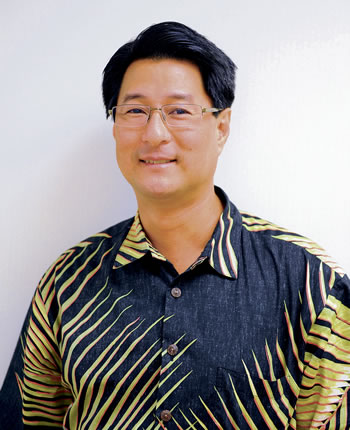Miracle News For Ex-Columnist
Dr. Hingson Chun
Interviewed By Rasa Fournier
Electrophysiologist at Straub Clinic & Hospital
Where did you receive your schooling and training?
I went to Roosevelt High School, then the University of Hawaii John A. Burns School of Medicine. From there I went to Ann Arbor, Mich., and did my medicine residency. Then I went to Stanford, where I did my cardiology and electrophysiology fellowships. Electrophysiology is a subspecialty of cardiology that looks at rhythm disturbances of the heart.
How long have you been practicing?
Since 1995.
What is atrial fibrillation?
It is a diagnosis that applies to a large family of atrial rhythm disorders. There are many different types of atrial fibrillation. It is the most common, continuous arrhythmia in humans. Every year that we age, our risk of having atrial fibrillation increases. It’s like an eyesight problem or hearing problem. Most patients with atrial fibrillation do quite well.
Former MidWeek columnist Eddie Sherman is a patient of yours. (Note: Sherman gave written permission for Chun to speak with MidWeek about his health history.)
In the case of Eddie, he’s had two heart surgeries, he’s advanced in years he is a common type of atrial fibrillation patient. Patients like Eddie are advised to take a blood thinner because when the top chamber of the heart is fibrillating, it’s vibrating, not pumping, so little blood clots form the size of half a grain of rice in little pockets of the atria. These can break off and go up into the brain and cause a stroke, or go into the bowel and cause stomach pain.
What was very unusual about Eddie Sherman, and totally unexpected, is that for some strange reason he converted back to a normal rhythm. It’s truly remarkable. He’d had atrial fibrillation for many years. Atrial fibrillation is like eyesight. Remember Spider-Man, where he gets bitten by that spider and he’s looking in the mirror and he no longer needs his glasses? Generally speaking, our eyesight never gets spontaneously better. Generally speaking, in patients like Eddie, he would not be expected to go back into a normal rhythm. Doctors would bet cases of beer against that.
More recently there have been very exciting and complicated procedures to attempt to cure some patients of atrial fibrillation. These are generally reserved for younger patients who are terribly symptomatic. I just saw a former classmate from Roosevelt who did undertake an ablation procedure. He’s doing great. He’s not afflicted with heart racing, pounding, or feeling short of breath. Atrial fibrillation ablation is a brand new technique, which is growing. It acquires tremendous training. It’s far more invasive and involved and prolonged a procedure than any of the ablations that we’ve classically performed for heart rhythms, for the simple reason that in order to cure somebody of atrial fibrillation, you need to do a whole lot of work. If there’s a puka in a boat, plug it up you’re done, but if the wood beams are separating, you’ve got to seal the whole hull. It takes a lot of work. That’s in essence what we’re trying to do with atrial fibrillation. Patients like Eddie would probably never be referred for that procedure because it’s very prolonged, and given his age and prior heart surgeries, the best ablation attempts are probably going to be met with recurrences.
The fact that Eddie recovered sinus rhythm (normal heartbeat) on his own is, like, holy smokes.
Does atrial always mean heart?
The top chamber of the heart is the atrium. When you walk through a building, the atrium is the first chamber you enter. So blood comes back from circulating through the body to the heart and enters the atrium. There’s a right atrium and a left atrium; it’s a thinwalled structure. It’s very different from the rest of the heart, which is more beefy. And the atria, because they’re thin-walled, are actually more likely to undergo fibrosis and dilatation, and stretching and enlargement. That’s what sets them up for continuous fibrillation in which there’s this wavy vibration of the atrium.
How common is atrial fibrillation?
It’s extremely common. By the age of 80, probably one out of eight human beings are in atrial fibrillation all the time. It’s very rare for there to be an identifiable cause of atrial fibrillation. Drug abuse or genetics can do it, but 99 percent of the time it’s unidentifiable.
Eddie said he was nearly on the operating table when he got the good news about his atrial fibrillation being gone.
We were going to revise his pacemaker and give him a fancy complicated pacemaker. The heart is a three-dimensional flesh pump that has to activate all at the same time to pump most efficiently. When we put in a pacemaker, we are creating the antithesis of that. We are pacing the heart from a single point. Where that electrode touches the heart, it emits a pulse and the part closest to the wire contracts first while other parts are relaxed, so you get this wiggly-jiggly dissynchrony. That’s undesirable, especially in patients who have had heart surgery like Eddie. Because his top chamber was fibrillating all the time, we were pacing the bottom all the time. He was getting weaker, his heart was getting weaker. So we wanted to do this fancy procedure where I put a lead on the far side of his heart where now we’re polarizing the heart from both sides and mimicking nature’s electrical activation.
Well, he comes in for pre-op counseling and, indeed, he’s back in sinus rhythm. When you’re in sinus rhythm your heart is, in his case, utilizing its intrinsic wiring, so his synchronization is restored. And we don’t have to do the procedure. It’s the first case I’ve ever seen. It’s totally unexpected. It’s like saying I found an In-NOut Burger stand at the top of Haleakala.







